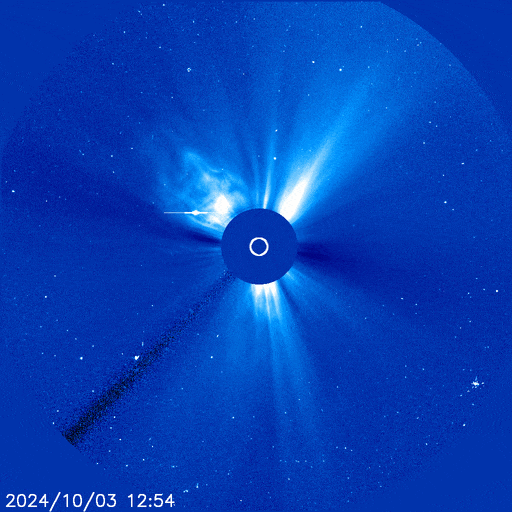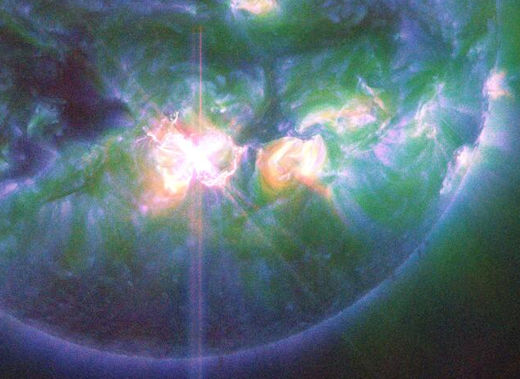Aurora australis as seen from the Australian and New Zealand mainlands
Cool, but I missed it.
Aurora australis as seen from the Australian and New Zealand mainlands
Cool, but I missed it.
Does an aurora emit x-rays?
yes

X-ray emission from northern aurora observed by the Polar Satellite (
noice
As usual, I was living in false hope. I’ve seen it from this location twice but this time isn’t going to be one of those.
Heads up Aurora watchers:
.
Sunspot AR3842 exploded again today, producing the strongest solar flare of Solar Cycle 25 so far. NASA’s Solar Dynamics Observatory recorded the X9.1-category blast:
Two CMEs are now heading for Earth following consecutive X-flares (X7.1 and X9.1) from active sunspot AR3842. According to NOAA and NASA models, the first will strike Earth on Oct 4th and the second (more potent) will strike on Oct. 6th. The dual impacts could spark strong G3-class geomagnetic storms with auroras at mid-latitudes.


Kingy said:
Heads up Aurora watchers:.
Sunspot AR3842 exploded again today, producing the strongest solar flare of Solar Cycle 25 so far. NASA’s Solar Dynamics Observatory recorded the X9.1-category blast:
Two CMEs are now heading for Earth following consecutive X-flares (X7.1 and X9.1) from active sunspot AR3842. According to NOAA and NASA models, the first will strike Earth on Oct 4th and the second (more potent) will strike on Oct. 6th. The dual impacts could spark strong G3-class geomagnetic storms with auroras at mid-latitudes.
Nice. I suppose by mid-latitudes they mean 45° north and south.
So It’s unlikely I’ll see one here (25.9° S). Bummer.
Michael V said:
Kingy said:
Heads up Aurora watchers:.
Sunspot AR3842 exploded again today, producing the strongest solar flare of Solar Cycle 25 so far. NASA’s Solar Dynamics Observatory recorded the X9.1-category blast:
Two CMEs are now heading for Earth following consecutive X-flares (X7.1 and X9.1) from active sunspot AR3842. According to NOAA and NASA models, the first will strike Earth on Oct 4th and the second (more potent) will strike on Oct. 6th. The dual impacts could spark strong G3-class geomagnetic storms with auroras at mid-latitudes.
Nice. I suppose by mid-latitudes they mean 45° north and south.
So It’s unlikely I’ll see one here (25.9° S). Bummer.
Tamb said:
Michael V said:
Kingy said:
Heads up Aurora watchers:.
Sunspot AR3842 exploded again today, producing the strongest solar flare of Solar Cycle 25 so far. NASA’s Solar Dynamics Observatory recorded the X9.1-category blast:
Two CMEs are now heading for Earth following consecutive X-flares (X7.1 and X9.1) from active sunspot AR3842. According to NOAA and NASA models, the first will strike Earth on Oct 4th and the second (more potent) will strike on Oct. 6th. The dual impacts could spark strong G3-class geomagnetic storms with auroras at mid-latitudes.
Nice. I suppose by mid-latitudes they mean 45° north and south.
So It’s unlikely I’ll see one here (25.9° S). Bummer.
My 17° 36 will just about rule it out.
I’m a little closer at 34.17°S
Tamb said:
Michael V said:
Kingy said:
Heads up Aurora watchers:.
Sunspot AR3842 exploded again today, producing the strongest solar flare of Solar Cycle 25 so far. NASA’s Solar Dynamics Observatory recorded the X9.1-category blast:
Two CMEs are now heading for Earth following consecutive X-flares (X7.1 and X9.1) from active sunspot AR3842. According to NOAA and NASA models, the first will strike Earth on Oct 4th and the second (more potent) will strike on Oct. 6th. The dual impacts could spark strong G3-class geomagnetic storms with auroras at mid-latitudes.
Nice. I suppose by mid-latitudes they mean 45° north and south.
So It’s unlikely I’ll see one here (25.9° S). Bummer.
My 17° 36 will just about rule it out.
Unless it is sufficiently powerful to provoke a Carrington-type event.
“The aurora was also visible from the poles to low latitude areas such as south-central Mexico, Cuba, Hawaii, Queensland, southern Japan and China, and even at lower latitudes very close to the equator, such as in Colombia.”
https://en.wikipedia.org/wiki/Carrington_Event